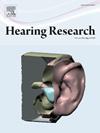EEG responses to onset-edge and steady-state segments of continuous speech under selective auditory attention modulation
IF 2.5
2区 医学
Q1 AUDIOLOGY & SPEECH-LANGUAGE PATHOLOGY
引用次数: 0
Abstract
Electroencephalography (EEG) signals provide valuable insights into the neural mechanisms of speech perception. However, it still remains unclear how neural responses dynamically align with continuous speech under selective attention modulation in the complex auditory environments. This study examined the evoked and induced EEG responses, their correlations with speech features, and cortical distributions for the target and ignored speech in two-talker competing scenarios. Results showed that selective attention increased the evoked EEG power for the target speech compared to the ignored speech. In contrast, the induced power indicated no significant differences. Low-frequency EEG power and phase responses reliably indexed the target speech identification amid competing streams. Cortical distribution analyses revealed that the evoked power differences between the target and ignored speech were concentrated in the central and parietal cortices. Significant induced power differences between the target and ignored speech presented only at the onset-edge segments in the left temporal cortex. Comparisons between onset-edge and steady-state segments showed the evoked power differences in the right central and temporal cortices and the induced power differences in the frontal cortex for the ignored speech. No significant differences of the cortical distribution were observed between the onset-edge and steady-state segments for the target speech. These findings underscore the distinct contributions of the evoked and induced neural activities and their cortical distributions to selective auditory attention and segment-specific speech perception.
选择性听觉注意调制下连续语音起始边缘段和稳态段的脑电反应
脑电图(EEG)信号为语言感知的神经机制提供了有价值的见解。然而,在复杂的听觉环境中,神经反应是如何在选择性注意调节下与连续语音动态对齐的,目前还不清楚。本研究考察了两说话者竞争情景下诱发和诱导的脑电反应、它们与语言特征的相关性以及目标语言和被忽略语言的皮层分布。结果表明,选择性注意使目标语音的脑电功率比被忽略语音的脑电功率增加。相比之下,诱导功率没有显着差异。低频脑电功率和相位响应可靠地索引了竞争流中的目标语音识别。皮层分布分析表明,目标言语和忽略言语的诱发功率差异主要集中在中央和顶叶皮层。目标语和被忽略语之间的诱导功率差异仅在左侧颞叶皮层的起始边缘部分出现。起始边缘段与稳态段的对比显示,忽略言语在右侧中央皮层和颞叶皮层的诱发功率存在差异,额叶皮层的诱发功率存在差异。在目标语音的起始边缘段和稳态段之间,皮层分布无显著差异。这些发现强调了诱发和诱导的神经活动及其皮层分布对选择性听觉注意和片段特异性言语感知的不同贡献。
本文章由计算机程序翻译,如有差异,请以英文原文为准。
求助全文
约1分钟内获得全文
求助全文
来源期刊

Hearing Research
医学-耳鼻喉科学
CiteScore
5.30
自引率
14.30%
发文量
163
审稿时长
75 days
期刊介绍:
The aim of the journal is to provide a forum for papers concerned with basic peripheral and central auditory mechanisms. Emphasis is on experimental and clinical studies, but theoretical and methodological papers will also be considered. The journal publishes original research papers, review and mini- review articles, rapid communications, method/protocol and perspective articles.
Papers submitted should deal with auditory anatomy, physiology, psychophysics, imaging, modeling and behavioural studies in animals and humans, as well as hearing aids and cochlear implants. Papers dealing with the vestibular system are also considered for publication. Papers on comparative aspects of hearing and on effects of drugs and environmental contaminants on hearing function will also be considered. Clinical papers will be accepted when they contribute to the understanding of normal and pathological hearing functions.
 求助内容:
求助内容: 应助结果提醒方式:
应助结果提醒方式:


